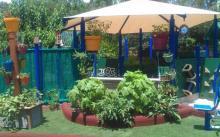
Plants & Play, a R&D division of Mosteller Design and Construction, Inc., designs garden play spaces for all age groups, from infants through seniors. Plants & Play structures encourage children and adults to play and move in a “Lean, Green, Serene” environment that is safe and easy to supervise.1 They believe that “the more 'high-tech' we become, the more nature we need,” and they are filling that need with Diverse Interactive Garden play environments, which include Veggie Trails, Vertical Gardens, and Secret Play Gardens.2
Jim Mosteller, who has a Bachelor of Arts degree and a Master of Science degree in Psychology and Physical Education as well as more than 30 years designing and installing playground equipment, began exploring how to combine plants and play. Having been raised in his family's nursery business, Jim felt that today's childhood physical challenges of obesity, hypertension, diabetes, and attention deficit disorder could be mitigated by getting children outside in green environments.
In 2005, Jim came up with 100 ideas of how to integrate plants with play and then built the top 10 into his front yard. From that beginning Jim, known as “Jungle Jim, the play garden man,” designed play spaces both by adding interactive planters into play events and by adding play events into vertical garden stand-alones.3 The results were Secret Play Gardens that incorporate his “Lean, Green, and Serene reciPE” solution to childhood ailments: Lean through movement that develops physical “strength, balance, flexibility, coordination, and endurance;” Green through growing fruits and vegetables for a “seeds to sandwich” experience; Serene through play spaces that are “an outdoor recess and science lab combined;” and reciPE to underscore the Physical Education component through their Veggie Trails, a combination of stand alone play and garden events.4
The designs created by Plants & Play draw inspiration from a broad spectrum of literature and experts, including Last Child in the Woods and The Nature Principle by Richard Louv, Asphalt to Ecosystem by Sharon Danks, Vertical Gardening by Derek Fell, Sanctuary Gardening by Christopher McDowell and Tricia McDowell, Plants for Play by Robin Moore, the Natural Learning Initiative in North Carolina State University, and the Edible Landscaping Online website.5 Some of their design features include a variety of entrances, gathering places, controlled water systems for plants, play panels, play events, garden mazes, weather indicators, bird attractors, shade areas, solitude spaces, accessible paths, garden art, and interactive planters.6
Jim's designs went from prototypes to finished projects in 2011 with the Riverbanks Zoo and Botanical Garden in Columbia, South Carolina, and the Little People's Child Development Center in Durham, North Carolina. Through their play gardens and veggie trails, Plants & Play seeks to open “mental doors to health, creativity, and wonder.”7
- 1. “Welcome to PlantsandPlay.com.” Plants & Play. < http://www.plantsandplay.com/ > 21 March 2012.
- 2. “Lean. Green. Serene.” Plants & Play. < http://www.plantsandplay.com/philosophy/ > 21 March 2012.
- 3. Mosteller, Jim. Personal correspondence to Playground Professionals. 23 March 2012.
- 4. Mosteller, Jim. “Inventions for Healthier American children.” Personal correspondence to Playground Professionals. 19 March 2012.
- 5. Op.cit., “Lean, Green, Serene.”
- 6. Mosteller, Jim. “The PS Child's Secret Garden features and benefits.” Personal correspondence to Playground Professionals. 23 March 2012.
- 7. Op.cit., “Lean, Green, Serene.”

